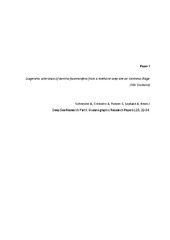| dc.contributor.advisor | Panieri, Giuliana | |
| dc.contributor.author | Schneider, Andrea | |
| dc.date.accessioned | 2018-05-23T12:55:49Z | |
| dc.date.available | 2018-05-23T12:55:49Z | |
| dc.date.issued | 2018-05-02 | |
| dc.description.abstract | Methane is a powerful greenhouse gas and its atmospheric concentrations varied throughout the geological history. Large amounts of methane are stored in seafloor sediments and society is apprehensive that some of this methane may enter the water column and atmosphere.
Vestnesa Ridge, located offshore north-western Svalbard, is one of the northernmost known active methane seeps. This PhD project aims at gaining a better understanding about 1) when methane release from Vestnesa Ridge occurred throughout the past 24000 years, 2) how can this be recorded, 3) why was the methane released, and 4) can periods of methane release be linked to regional environmental changes?
Foraminifera, single-celled organisms that float in the water column or live at the seafloor, help answering those questions. Foraminifera build shells from calcite that are often well-preserved in marine sediments. When methane is released from the seafloor, a different type of calcite encrusts those shells. Investigating the changes in calcite composition over time uncovers periods of past methane release started as the massive ice sheet covering Svalbard and the Barents Sea began retreating 24 000 years ago, and extent until today.
Such knowledge helps understanding whether methane release is a recent phenomenon or weather it is a natural process that persists over long time scales. This research contributes to our knowledge of climate change and can inform models used for predictions of future climate change. | en_US |
| dc.description.doctoraltype | ph.d. | en_US |
| dc.description.popularabstract | Methane is a powerful greenhouse gas and its atmospheric concentrations varied throughout the geological history. Large amounts of methane are stored in seafloor sediments and society is apprehensive that some of this methane may enter the water column and atmosphere.
Vestnesa Ridge, located offshore north-western Svalbard, is one of the northernmost known active methane seeps. This PhD project aims at gaining a better understanding about 1) when methane release from Vestnesa Ridge occurred throughout the past 24000 years, 2) how can this be recorded, 3) why was the methane released, and 4) can periods of methane release be linked to regional environmental changes?
Foraminifera, single-celled organisms that float in the water column or live at the seafloor, help answering those questions. Foraminifera build shells from calcite that are often well-preserved in marine sediments. When methane is released from the seafloor, a different type of calcite encrusts those shells. Investigating the changes in calcite composition over time uncovers periods of past methane release started as the massive ice sheet covering Svalbard and the Barents Sea began retreating 24 000 years ago, and extent until today.
Such knowledge helps understanding whether methane release is a recent phenomenon or weather it is a natural process that persists over long time scales. This research contributes to our knowledge of climate change and can inform models used for predictions of future climate change. | en_US |
| dc.description.sponsorship | This research was supported by the Research Council of Norway through its Centre of Excellence funding scheme for CAGE (project number 223259), the NORCRUST project (grant number 255150), the Faculty of Science and Technology at UiT, and the PNRA Project FORMAT. | en_US |
| dc.description | The papers II and III of this thesis are not available in Munin. <p>
Paper II: Schneider, A., Panieri, G., Lepland, A., Consolaro, C., Crémière, A., Forwick, M., Johnson, J. E., Plaza-Faverola, A., Sauer, S., Knies, J. Seafloor methane seepage at Vestnesa Ridge (NW Svalbard) since the Last Glacial Maximum.
(Manuscript).
<br>
Paper III: Schneider, A., Hong, W-L., & Panieri, G. Diagenetic alteration of foraminifera reveals minimum methane seepage duration. (Manuscript). | en_US |
| dc.identifier.isbn | 978-82-8236-294-8 (trykt) og 978-82-8236-295-5 (pdf) | |
| dc.identifier.uri | https://hdl.handle.net/10037/12780 | |
| dc.language.iso | eng | en_US |
| dc.publisher | UiT Norges arktiske universitet | en_US |
| dc.publisher | UiT The Arctic University of Norway | en_US |
| dc.relation.projectID | info:eu-repo/grantAgreement/RCN/SFF/223259/NORWAY/Centre for Arctic Gas Hydrate, Environment and Climate/CAGE/ | en_US |
| dc.relation.projectID | info:eu-repo/grantAgreement/RCN/PETROMAKS2/255150/NORWAY/Norwegian margin fluid systems and methane- derived carbonate crusts - Recent scientific advances in service of petroleum exploration// | en_US |
| dc.rights.accessRights | openAccess | en_US |
| dc.rights.holder | Copyright 2018 The Author(s) | |
| dc.rights.uri | https://creativecommons.org/licenses/by-nc-sa/3.0 | en_US |
| dc.rights | Attribution-NonCommercial-ShareAlike 3.0 Unported (CC BY-NC-SA 3.0) | en_US |
| dc.subject | VDP::Mathematics and natural science: 400::Geosciences: 450::Marine geology: 466 | en_US |
| dc.subject | VDP::Matematikk og Naturvitenskap: 400::Geofag: 450::Marin geologi: 466 | en_US |
| dc.title | Diagenetically altered benthic foraminifera reveal paleo-methane seepage | en_US |
| dc.type | Doctoral thesis | en_US |
| dc.type | Doktorgradsavhandling | en_US |


 English
English norsk
norsk

